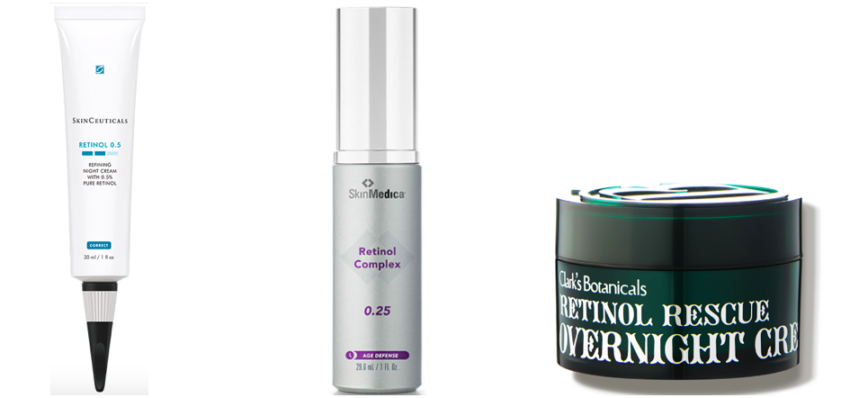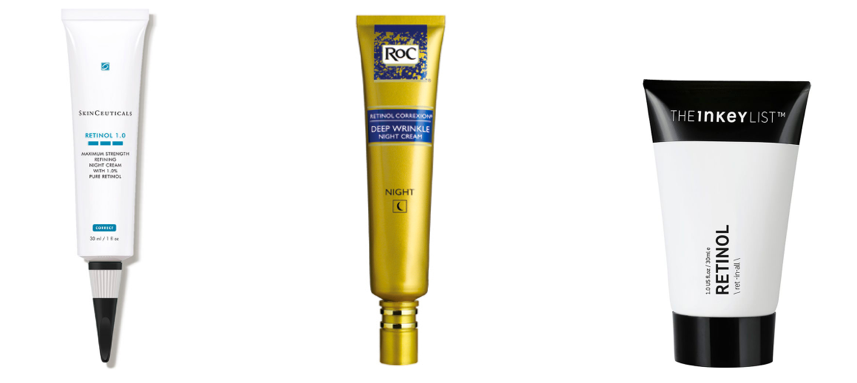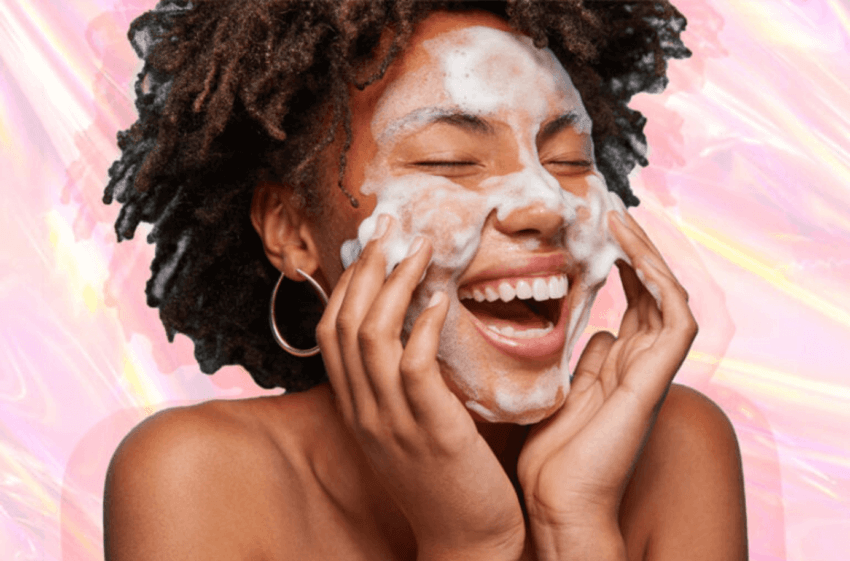Your Ultimate Guide To Using Retinol! Everything You Need To Know...

Without fail, every dermatologist we’ve ever spoken to has told us to use retinol (aka retinoids, Retin-A, granactive retinoids). Whether we’re asking for advice on dealing with oily skin, acne, uneven skin tone, fine lines or just how to get healthy, glowing skin, they’ll always name drop this miracle ingredient and insist that retinol is the answer to all our skincare problems. Think of it as the Beyoncé of the skincare world – a skincare star.
But with any skincare cure-all as powerful as retinol, comes a lot of questions and inevitably some confusion. So, it’s essential to know the basics: what it is, how it works, when to use it, as well as the answers to the slightly more complicated questions like, WTF is the difference between a retinoid and retinol? We spoke to two expert dermatologists for the full low down on how to use retinol; Dr. Doris Day, celeb dermatologist and author of Beyond Beautiful, and NYC-based Board-Certified dermatologist, Dr. Shereene Idriss, who specializes in facial aesthetics and rejuvenation. Here’s everything you need to know about introducing retinol into your routine:
What is Retinol?
Retinol essentially helps to boost collagen production, speed up cell turnover, tighten pores, smooth skin texture, brighten the complexion, reduce fine lines and wrinkles, and control excess oil production – pretty impressive!
Retinol and Retin-A are both referred to as retinoids, but they’re essentially a slightly different type of vitamin A. Dr. Day explains that there are “Several forms of vitamin A which are used in skincare products, the most common types are retinol, retinyl esters (e.g., retinyl acetate, retinyl propionate, and retinyl palmitate), and retinaldehyde. These are the ingredients you may see listed on the package label.”
 via Giphy
via Giphy
How Does Retinol Work?
Dr. Day explains that “Retinols act on specific receptors, or targets in the skin, which helps to promote more normal maturation of skin cells. They also promote collagen production and lots of other healthy processes in different layers of the skin to help your skin look and feel healthy, smooth and even in tone.”
Dr. Idriss adds, “In the long run, it delivers a clearer and tighter complexion. It works on all skin tones and types but should be introduced cautiously into your regimen, especially if you have sensitive skin.”
How Does Retinol Work for Acne, Wrinkles, and Hyperpigmentation?
Acne: “Retinol isn’t an antibiotic, but what it does in acne is help the skin cells that line the pores to turnover more normally, which helps avoid clogged pores and this helps prevent the pimples and blackheads of acne. It works great with other acne treatments to help clear the skin, treat existing pimples and prevent new pimples,” Dr. Day says. Speak to your doctor about a Retin-A prescription (Tretinoin), as this is the most effective form of retinoids for treating acne.
Sun damage/wrinkles: According to Dr. Day, “Retinols can help reduce sun damage effects in the skin. It helps make the deeper layers of the skin ‘thicker,’ boost collagen production, and it also blocks an enzyme called collagenase that’s triggered by the sun to breakdown collagen.” Although it’s important to note that retinol is too harsh to be used on skin that has recently been damaged, so avoid applying it to sunburn.
Hyperpigmentation: “Retinols may act on various pathways of pigmentation and normalize those pathways as well as normalizing skin cell turnover. These effects lead to smoother, more even skin tone and radiant skin. I even recommend retinol for my patients with sensitive skin and rosacea – I carefully pick the formulation and combine it with other ingredients to minimize redness and optimize results.” Dr. Day tells us.
Top Tip: It’s also a great idea to add other antioxidants, like peptides and growth factors to enhance the effect of retinol on your skin.
 via Giphy
via Giphy
How Often Should You Use Retinol?
Dr. Idriss states that “It is crucial that you slowly build up a tolerance to the retinol by starting once or twice a week for two weeks, then slowly adding on a day every two weeks until you feel you can tolerate it.” Adding that “Some amount of irritation and redness is considered normal, especially in the first few introductory weeks of any retinol. If you experience it, it should be mild and manageable. It shouldn’t be so red or flaky that it can be spotted across the room.”
Top Tip: Dr. Idriss says that “It’s equally important that you understand your own face and learn where on your face you can tolerate it. For example, despite having built a tolerance, I personally cannot use it around my mouth as it perpetually leads to extreme flaking and redness.”
Posts You'll Love:
When Can I Start Using Retinol?
When you introduce retinol into your skincare routine (which, btw, should be in your 20s), an over-the-counter product is fine. However, when you turn 30, most dermatologists suggest that it’s time to get started on a prescription-strength retinoid.
When Should I Use Retinol in My Skincare Routine?
Retinols should typically be applied at night, as the active ingredient can be sensitive to light. However, Dr. Day told us that “some retinol is photo-stabilized and can be used during the day, but this should be written on the package, so you’ll know it’s ok to use during the day.”
It’s also really important to always wear SPF the following day – you should use SPF every day anyway – as your skin is more vulnerable.
How Long Does Retinol Take to Work?
This is where a little patience comes in! The thing is, prescription-strength retinoids can take three months for visible results, while over-the-counter retinol products can take six to 12 months to see really noticeable results.
Dr. Day’s Fave Retinol Products:
 Source: Olay, Neutrogena, philosophy
Source: Olay, Neutrogena, philosophy
- Olay Eyes Pro-Retinol Cream Treatment For Crows Feet, $33: Paired with antioxidant-rich niacinamide, this retinol fights crow’s feet in just four weeks.
- Neutrogena Rapid Wrinkle Regenerating Cream $28: A hydrating, retinol-enriched formula that can be used twice daily for speedy results.
- Philosophy Anti-Wrinkle Miracle Worker, $24: A fusion of wrinkle-fighting retinol and a complex of peptides, hyaluronic acid, and vitamin C elevate this formula.
Posts You'll Love:
Does Retinol Cause Dryness, and is That Normal?
In short, yes, but only at first. Dr. Day assures us that “When you first start using a retinoid you may experience peeling as part of that process, although it is not exfoliation. For example, glycolic acid, salicylic acid, and lactic acid or other exfoliating ingredients make the skin cells less sticky by loosening the glue that holds skin cells together, which can cause peeling and exfoliation. Retinols don’t have that same effect. Instead, retinols help normalize skin cell turnover, which can initially cause peeling because the skin cells normalize and mature, then slough off more appropriately.”
Dr. Day assures us that after the initial introduction “The peeling will slow down or stop, and the skin looks smoother and more radiant. If you keep peeling, you may need to switch to a different formulation of retinol or increase moisturization along with it.”
 via Giphy
via Giphy
Can You Use Exfoliator and Retinol Together?
Dr. Idriss recommends “Exfoliating on the days that you do not use any retinol in order to minimize any potential irritation.” As a typical rule, Dr. Day says, “You may need to exfoliate less often since the stratum corneum (the very outer layer of dead skin cells that can pile up and make your skin look dull), becomes more compact and smoother when you use retinoids. Depending on your overall skin quality and other conditions, you may also want to consider switching to more gently lactic or phytic acids instead of glycolic acid.”
What’s the Difference Between Over-the-Counter Retinol and Prescription Retinol?
All skincare products are not created equally, which means some products will have a stronger form of retinol and others will have a higher concentration. You may see it listed as granactive retinoid, retinol or Retin-A. Retinoid is the name of the active ingredients, retinol and Retin-A are different concentrations of retinoids: retinol is the weakest form that you can get over the counter. Here’s the breakdown:
Retinol: Retinol is the weakest form of retinoids (it is still strong in comparison to other skincare ingredients), but it’s also the most easily tolerated by the skin. Retinol needs time to be converted into retinoic acid (the active form of vitamin A) when it comes into contact with your skin. This makes retinol the mildest retinoid, but also the most well tolerated by the skin.
Retin-A (also known as Tretinoin): This is most commonly found in prescription-strength acne and aging formulas. Unlike retinol, Retin-A doesn’t need to be broken down by the enzymes in your skin, as it converts directly into retinoic acid. This makes it roughly 20 times stronger than retinol.
When it comes to retinol, stronger does not mean better! It’s important to start slow and begin with a formula that your skin can comfortably tolerate. If you dive in at the deep end, chances are you won’t end up wanting to use the product due to the unpleasant side effects that can occur – redness, dry skin, itching, even breakouts.
Posts You'll Love:
The MOST Important Retinol Rule:
Every dermatologist stresses the importance of using an SPF! Because retinol helps your skin become younger and healthier, that skin is more sun-sensitive. Dr. Day says “It’s always important to use sunscreen and be sun smart every day, all year round, to prevent wrinkles, blotchy skin, and skin cancer. It’s the single most important way to make sure you age beautifully.” Dr. Idriss agrees that retinol “May make you slightly more sun-sensitive, but regardless you should always practice sun-safe methods and apply a minimum of SPF 30 on a daily basis!”
Dr. Idriss’ Fave Retinol Products:
 Source: Skinceuticals, SkinMedica, Clark’s Botanicals,
Source: Skinceuticals, SkinMedica, Clark’s Botanicals,
- Skinceuticals retinol 0.5 refining night cream, $76: A concentrated formula with pure retinol to improve fine lines and minimize pores and breakouts.
- Skinmedica 0.25 retinol complex, $62: A mild retinol to improve skin tone and texture. The mild formula makes it ideal for 20-something skin and retinol newbies.
- Clark’s Botanicals Retinol Rescue Overnight Cream, $105: An award-winning ingredient ideal for sensitive skin types.
How to Tell the Difference Between a Retinol Purge and a Breakout:
 via Giphy
via Giphy
Purging is a skin process that often occurs when you start using an exfoliating product that encourages skin cell turnover, so when you first start using retinol, purging is common. For the first couple of weeks, as your cell turnover intensifies (this is a good thing) your pores will de-bunk (again this is good), however, it can feel and look like your skin is breaking out. This is why it’s important to introduce retinol gradually into your regime.
A purge is often mistaken with a breakout; the difference is that a ‘purge’ will happen almost immediately after you use retinol and will be widespread, whereas a breakout will occur in groups. A purge shouldn’t last longer than two to four weeks, if it does, then check in with your dermatologist and stop using the product.
Our Fave Retinol Products:
 Source: SkinCeuticals, Roc, The Inkey List
Source: SkinCeuticals, Roc, The Inkey List
- SkinCeuticals 1.0 Maximum Strength Refining Night Cream, $88: A super-charged retinol formula to treat everything!
- Roc Retinol Correxion Deep Wrinkle Night Cream, $25: The number one drugstore retinol that promises to reduce expression lines and deep wrinkles in 12 weeks!
- The Inkey List Retinol, $13: An affordable yet effective 1% retinol serum. Read the full review.
Retinol Key Takeaways:
- Retinoids are the star of the skincare world and can help to improve enlarged pores, hyperpigmentation, acne, fine lines, and scarring.
- Start your retinoid journey with an over-the-counter retinol before moving to a prescription.
- If you have sensitive skin or a history of eczema, stick with retinol, and introduce it extra slowly into your routine. If that doesn’t work, check out the natural alternative to retinol, bakuchiol.
- Be prepared for a potential purging or peeling process when you begin using retinol.
- ALWAYS wear sunscreen when using retinol; at least SPF 30 with a 4-star UVA rating or higher.
- Use retinol at night only, unless it specifies otherwise.
- If you’re still unsure of what to begin with, check with your dermatologist first.
Have you guys tried retinol before? Let us know if you have any more questions in the comments below.
Disclaimer: Every product we review has been independently selected and tested without bias by our editorial team. We never take payment to review products, however, some brands allow affiliate links, so we may earn a commission if you purchase a product by clicking on one of our links.





















Leave a comment